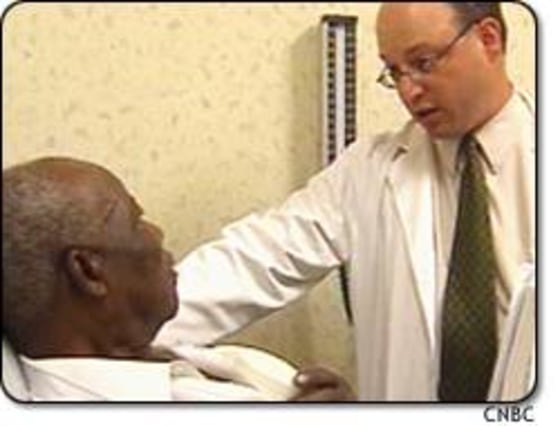A new medical technology called “telemedicine” is taking off. The AARP reports that a baby boomer becomes a senior citizen every 7.5 seconds. And that aging population is embracing technology and taking a more active role in their own healthcare. The demand is fueling a race to deploy thousands of new devices each year, some of which could save some of 500,000 Americans who die each year from sudden cardiac arrest.
Less than six months after 86-year-old Ken Hall got a Biotronik cardiac defibrillator implant, it saved his life. The retired Newark, N.J. sanitation worker never felt a thing. But his doctor got a wireless “wake up call.”
Cardiologist Dr. Roy Saurberman, notified by fax that his patient had suffered a heart episode, called Hall in for an unscheduled office visit, where he told him for the first time what had happened.
“You had what we call ventricular tachyacardia, a potentially life-threatening heart rhythm disturbance,” he said. “The good news is the defibrillator’s working, you’ve got a guardian angel over you. Your life is protected, and you’re going to do very well.”
“Thank you,” said Hall. “Thank you, doctor, wonderful.”
A $5 billion market
The grandfather of Hall’s implant, the first cardiac defibrillator, was patented in 1962. Those paddles became a familiar sight in American homes after countless cameos in TV medical shows and films.
Everything changed in 1980 when Dr. Levi Watkins Johns Hopkins implanted the first defibrillator, which was about the size of a cookie. Since then, more than 300,000 patients have received implantable cardiac defibrillators, also known as ICDs.
The device costs, on average, About $44,000 and last year made up a $5 billion market.
Now, in the new millennium, ICDs are speaking out, becoming 24/7 security guards for their owners.
The moment a Biotronik device detects irregular heart activity, it alerts the physician via fax. For Ken Hall and his family, the technology is simply a miracle.
“I feel a lot of insurance, because without this miracle I think sometimes it’s impossible to use the knowledge that God gives us,” he said.
Medical device giants Guidant and Medtronic are developing similar products. Medtronic is testing an implant in some 20,000 Veterans Administration patients. The Medtronic device uses the Internet, but isn’t automatic. The onus is still on the patient, who through a self-scanning process must deliver updates to their doctor.
But Sauberman believes the open window the Biotronik device offers is wireless nirvana.
“It’s been great,” he said. “Great in terms of us as physicians, nurses, medical care givers to be able to feel that we’re always watching, we’re always listening.”
Round-the-clock support
With real-time patient information a reality, the monitoring business is ready to explode. So look for Biotronik to hook up with the likes of Raytel Cardiac Services. Raytel is to your implant what the monitoring company is to your home alarm system. They already provide round-the-clock support for 12,000 cardiologists and 170,000 cardiac patients nationwide.
“There’s an increasing number of patients with implantable devices,” said Dr. Joseph Sappington, Raytel’s medical director. “And it frees us from having the patient come to the office every month. We can virtually make house calls over the telephone.”
For the millions of Americans living out their golden years up and down the Florida coast, telemedicine breakthroughs can bring the hospital closer to home.
So when the American Telemedicine Association hosted a fall forum at a posh South Florida resort, remote monitoring and home health solutions were center stage. Attendance nearly doubled expectations.
“The types of applications that are available have become more refined,” said John Linkous, the association’s director. “Clinical trials are over. The early studies of the efficacy of telemedicine — how well it works — have been proven.”
But for all its promise, medical technology is on a collision course with regulators. Industry advocates complain the FDA approval process is too slow and that Medicare adds to the drag, all of which is making for a highly unpredictable environment for investors and product developers. FDA Commissioner Mark McClellan says he hopes to jump start the process through a series of new initiatives.
“One is a new user fee program where the manufacturers of new devices will pay fees to us to review them,” he said. “That is additional resources that we can use to save time and save effort in getting products to patients.”
McClellan says private insurers, Medicare and his agency must have a meeting of the minds. And companies will have to share trade secrets with more than one regulator in order to get their products to market faster — if so many more people like Ken Hall are destined to have “technology guardian angels” monitoring every heartbeat.
(CNBC's Steve Lewis contributed to this report.)
